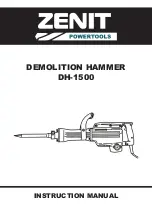
Manual 0-2746
27
SECTION 5: SERVICE
Right Side
Cut Angle
Left Side
Cut Angle
A-00512
Figure 5-2 Side Characteristics Of Cut
E. Dross
Generally when dross is present on carbon steel, it is re-
ferred to as either "high speed or slow speed dross".
"High speed dross" usually forms a narrow bead along
the bottom of the cut edge and is very difficult to remove.
"Slow speed dross" will be in larger quantities but does
not adhere tightly to the cut edge and can be easily re-
moved.
When cutting a troublesome steel, it is suggested that the
torch travel speed be reduced to produce "slow speed
dross". Any required cleanup can then be done by scrap-
ping, not grinding.
Dross present on top of the plate (top spatter), is normally
caused by a slow torch travel speed or too high of a torch
standoff distance.
F. Common Cutting Faults
1. Insufficient Penetration
a. Cutting speed too fast
b. Torch tilted too much
c. Metal too thick
d. Worn torch parts
e. Cutting current too low
2. Main Arc Extinguishes
a. Cutting speed too slow
b. Torch standoff too high from workpiece
c. Cutting current too high
d. Work cable disconnected
e. Worn torch parts
3. Excessive Dross Formation
a. Cutting speed too slow
b. Torch standoff too high from workpiece
c. Worn torch parts
d. Improper cutting current
4. Short Torch Parts Life
a. Oil or moisture in air source
b. Exceeding system capability (material too thick)
c. Excessive pilot arc time
d. Air flow too low (incorrect pressure)
e. Improperly assembled torch
5.04 Troubleshooting Guide
A. General
Troubleshooting and repairing this unit is a process which
should be undertaken only by those familiar with high
voltage high power electronic equipment.
WARNING
There are extremely dangerous voltage and power
levels present inside this unit. Do not attempt to
diagnose or repair unless you have had training in
power electronics measurement and troubleshoot-
ing techniques.
B. Basic Troubleshooting
This manual covers a basic level of troubleshooting that
requires limited dissasembly and measurements. It is
helpful for solving many of the common problems that
can arise with this system.
If major complex subassemblies are faulty, the unit must
be returned to an authorized service center for repair.
Follow all instructions as listed and complete each sec-
tion in the order presented.
For major troubleshooting and parts replacement pro-
cedures refer to PAK Master 75XL PLUS Power Supply
Service Manual 0-2747.
C. How to use this Guide
The following information is a guide to help the Cus-
tomer/Operator determine the most likely causes for
various symptoms.
This guide is set up in the following manner:
X. Symptom (Bold Type)
Any Special Instructions (Text Type)
Summary of Contents for CE PAK Master 75XL
Page 1: ...Manual No 0 2746 August 23 1999 Operating Manual A 02464 Air Plasma Cutting Power Supply...
Page 3: ...Purchase Date Power Supply Torch Record Serial Numbers For Warranty Purposes...
Page 4: ......
Page 41: ...Manual 0 2746 35 APPENDIX This Page Left Blank...
Page 43: ...Manual 0 2746 37 APPENDIX A 02503 OK OK TO MOVE 8 11 99...
Page 44: ...APPENDIX 38 Manual 0 2746...












































